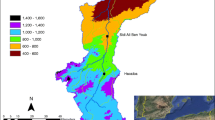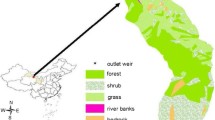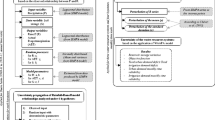Abstract
Hydrological models are simplified representations of natural processes and subject to errors. Uncertainty bounds are a commonly used way to assess the impact of an input or model architecture uncertainty in model outputs. Different sets of parameters could have equally robust goodness-of-fit indicators, which is known as Equifinality. We assessed the outputs from a lumped conceptual hydrological model to an agricultural watershed in central Chile under strong interannual variability (coefficient of variability of 25%) by using the Equifinality concept and uncertainty bounds. The simulation period ran from January 1999 to December 2006. Equifinality and uncertainty bounds from GLUE methodology (Generalized Likelihood Uncertainty Estimation) were used to identify parameter sets as potential representations of the system. The aim of this paper is to exploit the use of uncertainty bounds to differentiate behavioural parameter sets in a simple hydrological model. Then, we analyze the presence of equifinality in order to improve the identification of relevant hydrological processes. The water balance model for Chillan River exhibits, at a first stage, equifinality. However, it was possible to narrow the range for the parameters and eventually identify a set of parameters representing the behaviour of the watershed (a behavioural model) in agreement with observational and soft data (calculation of areal precipitation over the watershed using an isohyetal map). The mean width of the uncertainty bound around the predicted runoff for the simulation period decreased from 50 to 20 m3s−1 after fixing the parameter controlling the areal precipitation over the watershed. This decrement is equivalent to decreasing the ratio between simulated and observed discharge from 5.2 to 2.5. Despite the criticisms against the GLUE methodology, such as the lack of statistical formality, it is identified as a useful tool assisting the modeller with the identification of critical parameters.








Similar content being viewed by others
References
Beven K 2001 Rainfall-runoff modelling: The primer; John Wiley & Sons Inc, Sussex, England.
Beven K 2006 A manifesto for the equifinality thesis; J. Hydrol. 320 (1–2) 18–36.
Beven K and Binley A 1992 The future of distributed models: Model calibration and uncertainty prediction; Hydrol. Process. 6 (3) 279–298.
Beven K and Freer J 2001 Equifinality, data assimilation, and uncertainty estimation in mechanistic modelling of complex environmental systems using the GLUE methodology; J. Hydrol. 249 (1–4) 11–29.
Beven K, Smith P and Freer J 2007 Comment on “Hydrological forecasting uncertainty assessment: Incoherence of the GLUE methodology” by Pietro Mantovan and Ezio Todini; J. Hydrol. 338 (3–4) 315–318.
Beven K, Smith P and Freer J 2008 So just why would a modeller choose to be incoherent; J. Hydrol. 354 (1–4) 15–32.
Brazier R, Beven K, Freer J and Rowan J 2000 Equifinality and uncertainty in physically based soil erosion models: Application of the GLUE methodology to WEPP – the Water Erosion Prediction Project – for sites in UK and USA; Earth Surf. Process. Landforms 25 (8) 825–845.
Caddy J and Mahon R 1995 Reference points for fisheries management; In: FAO Fisheries Technical Paper, No. 347, Food and Agriculture Organization of the United Nations, Rome.
Chow V, Maidment Dm and Mays L 2005 Applied hydrology; McGraw-Hill, New York, USA.
Clark M, Slater A, Rupp D, Woods R, Vrugt J, Gupta H, Wagener T and Hay L 2008 Framework for Understanding Structural Errors (FUSE): A modular framework to diagnose differences between hydrological models; Water Resour. Res. 44 W00B02.
Crawford N and Burges S 2004 History of the Stanford watershed model; Water Resources Impact 6 (2) 3–5.
Ebel B and Loague K 2006 Physics-based hydrologic-response simulation: Seeing through the fog of equifinality; Hydrol. Process. 20 (13) 2887–2900.
Ferrer P, Brown E and Ayala L 1973 Simulación de gastos medios mensuales en una cuenca pluvial; In: II Coloquio Nacional de Ingeniería Hidráulica.
Gupta H, Beven K and Wagener T 2005 Model calibration and uncertainty estimation, In: Encyclopedia of Hydrologic Sciences (ed.) Anderson M E A, John Wiley & Sons Ltd, pp. 1–17.
Khu S and Werner M 2003 Reduction of Monte-Carlo simulation runs for uncertainty estimation in hydrological modelling; Hydrol. Earth Syst. Sci. 7 (5) 680–692.
Li L, Xia J, Xu C Y, Chu J and Wang R 2009 Analyse the sources of equifinality in hydrological model using GLUE methodology, In: Hydroinformatics in Hydrology, Hydrogeology and Water Resources, Proceedings of Symposium JS, 4 130–138.
Mantovan P and Todini E 2006 Hydrological forecasting uncertainty assessment: Incoherence of the GLUE methodology; J. Hydrol. 338 (3–4) 368–381.
Mantovan P, Todini E and Martina M L 2007 Reply to comment by Keith Beven, Paul Smith and Jim Freer on hydrological forecasting uncertainty assessment: Incoherence of the GLUE methodology; J. Hydrol. 338 (3-4) 319–324.
Mo X, Pappenberger F, Beven K, Liu S, De Roo A and Lin Z 2006 Parameter conditioning and prediction uncertainties of the LISFLOOD-WB distributed hydrological model; Hydrol. Sci. J. 51 (1) 45–65.
Montanari A 2007 What do we mean by “uncertainty”? The need for a consistent wording about uncertainty assessment in hydrology; Hydrol. Process 21 (6) 841–845.
Montecinos A and Aceituno P 2003 Seasonality of the ENSO-related rainfall variability in central Chile and associated circulation anomalies; J. Climate 16 281–296.
Muñoz E 2011 Perfeccionamiento de un modelo hidrológico: aplicación de análisis de identificabilidad dinámico y uso de datos grillados; PhD Thesis, University of Concepcion, Chile.
Muñoz E, Álvarez C, Billib M, Arumí J L and Rivera D 2011 Comparison of gridded and measured rainfall data for basin-scale hydrological studies; Chilean J. Agricultural Res. 71 (3) 459–468.
Muñoz E, Rivera D, Vergara F, Tume P and Arumí J L 2014 Identifiability analysis: Towards constrained equifinality and reduced uncertainty in a conceptual model; Hydrol. Sci. J., doi: 10.1080/02626667.2014.892205.
Nash J and Sutcliffe J 1970 River flow forecasting through conceptual models. Part I: A discussion of principles; J. Hydrol. 10 (3) 282–290.
Schaefli B and Gupta H 2007 Do Nash values have value? Hydrol. Process. 21 (15).
Shirmohammadi A, Chaubey I, Harmel R, Bosch D, Munoz-Carpena R, Dharmasri C, Sexton A, Arabi M, Wolfe M and Frankenberger J et al. 2006 Uncertainty in TMDL Models; Trans. ASABE 49 1033–1049.
Stedinger J, Vogel R, Lee S and Batchelder R 2008 Appraisal of the generalized likelihood uncertainty estimation (GLUE) method; Water Resour. Res. 44 W00B06.
Toro P 2009 Análisis del manejo de los recursos hídricos del río chillán; Master’s thesis, Department of Civil Engineering, University of Concepcion.
Viola F, Noto L, Cannarozzo M and La Loggia G 2009 Daily streamflow prediction with uncertainty in ephemeral catchments using the GLUE methodology; Phys. Chem. Earth 34 (10–12) 701–706.
Vrugt J, terBraak C, Gupta H and Robinson B 2009 Equifinality of formal (DREAM) and informal (GLUE) bayesian approaches in hydrologic modeling; Stoch. Env. Res. Risk A 23 (7) 1011–1026.
Wagener T and Kollat J 2007 Numerical and visual evaluation of hydrological and environmental models using the Monte Carlo analysis toolbox; Environ. Modell. Softw. 22 (7) 1021–1033.
Wagener T, Lees M and Wheater H 2001 A toolkit for the development and application of parsimonious hydrological models; In: Mathematical models of small watershed hydrology (eds) Singh Frevert and Meyer, 2 Water Resources Publications, LLC, USA.
Xiong L, Wan M, Wei X and O’Connor K 2009 Indices for assessing the prediction bounds of hydrological models and application by generalised likelihood uncertainty estimation; Hydrol. Sci. J. 54 (5) 852–871.
Zambrano M, Pagliero L, Rojas R and Gangas A 2005 Magic: Modelación integrada de cuencas y acuíferos. Serie Informes Técnicos 107, Dirección General de Aguas, Departamento de Estudios y Planificación.
Zhang D, Beven K and Mermoud A 2006 A comparison of non-linear least square and GLUE for model calibration and uncertainty estimation for pesticide transport in soils; Adv. Water Resour. 29 (12) 1924–1933.
Acknowledgements
The BFA model was coded in MATLAB by Dr© FulvioRivano and Leonardo Vega. Codes and datasets are available on request. This research was benefited from FONDECYT Grant Nos. 11090032 and 1110298. We thank Dr Claire Baffaut and Dr José Luis Arumí for their comments and suggestions. Thanks to Roto Quezada.
Author information
Authors and Affiliations
Corresponding author
Rights and permissions
About this article
Cite this article
Rivera, D., Rivas, Y. & Godoy, A. Uncertainty in a monthly water balance model using the generalized likelihood uncertainty estimation methodology. J Earth Syst Sci 124, 49–59 (2015). https://doi.org/10.1007/s12040-014-0528-7
Received:
Revised:
Accepted:
Published:
Issue Date:
DOI: https://doi.org/10.1007/s12040-014-0528-7




